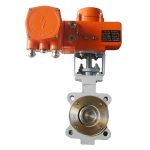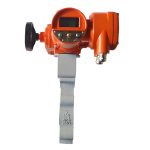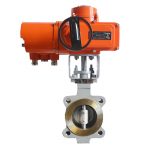II. Key Attribute Specifications
A. Dimensional & Pressure-Temperature Parameters
- Port Size: 3” (DN80), a widely adopted size in industrial pipelines that balances flow capacity and installation flexibility. Suitable for medium-scale process lines in refineries, chemical plants, and water distribution networks.
- Pressure Rating: Class 150 (2.0MPa), aligned with industrial medium-pressure requirements. The valve undergoes hydrostatic testing at 1.5× rated pressure for the body and 1.1× rated pressure for the seat, ensuring structural integrity and leak-tight sealing under operating conditions.
- Temperature Range: -20℃ to 200℃, enabled by WCB carbon steel’s thermal stability and compatible soft-sealing materials (e.g., EPDM, PTFE). This range accommodates ambient media, moderately heated fluids, and low-temperature industrial applications.
B. Material Composition
- Valve Body & Disc: WCB carbon steel (ASTM A216), offering tensile strength of 485–655MPa and yield strength ≥240MPa. This material withstands moderate corrosion, thermal stress, and mechanical impact in oil, gas, water, and steam services.
- Sealing System: Soft seals (EPDM or PTFE), providing chemical resistance and bubble-tight sealing. EPDM suits general industrial media (water, air, mild chemicals), while PTFE extends compatibility to aggressive acids, alkalis, and solvents.
- Valve Stem: Alloy steel (17-4PH or 410SS), precision-machined for strength and corrosion resistance, with an anti-blowout design to meet safety standards.
- Lug Flanges: WCB carbon steel, machined to ANSI B16.5 specifications for seamless integration with standard pipeline flanges.
C. Connection & Operational Features
- Connection Type: Lug-type flange (ANSI B16.5), allowing bolt-through installation that simplifies alignment and eliminates the need for pipeline rotation during maintenance. Lug-style connections are also ideal for retrofitting, as they can be installed between existing flanges.
- Operation Mode: Electric actuation (with manual override) as standard. The electric actuator enables automated control (e.g., via SCADA/DCS systems), while the manual override ensures operation during power outages—critical for process-critical applications.
- Safety & Compliance Features: API 609-compliant design, with optional fire-safe and low-emission configurations. The valve is permanently marked for material traceability and compliance with industry regulations.
D. Certifications & Compliance
- Industry Standards: API 609, ASME B16.5, ISO 5752, ISO 9001.
- Material Certifications: ASTM A216 (WCB), ASTM A564 (17-4PH).
- Regional Approvals: CE, ATEX (optional for hazardous environments).
III. Feature Description
A. Double Eccentric Design: Reduced Wear & Extended Service Life
B. WCB Carbon Steel Construction: Durability in Industrial Environments
C. Lug-Type Flange Connection: Installation Flexibility & Maintenance Ease
- Bolt-Through Installation: Lug flanges are drilled to allow bolts to pass through the valve and into the pipeline flanges, simplifying alignment and reducing installation time. This is especially beneficial in confined spaces or when retrofitting into existing systems.
- Isolation Capability: Lug valves can be installed with blind flanges on one side, enabling easy isolation for maintenance without disrupting the entire pipeline. In a chemical plant’s batch reactor feed line, this feature allows for quick valve inspection, minimizing downtime.
- Compatibility: Lug flanges conform to ASME B16.5, ensuring compatibility with standard pipeline flanges from other manufacturers. This interchangeability reduces inventory costs and streamlines procurement for multi-vendor projects.
D. Soft-Sealed Performance: Leak-Tight Media Containment
E. Electric Actuation with Manual Override: Automation & Safety

IV. Manufacturing Processes
A. Material Inspection & Preparation
- WCB Verification: Raw material billets undergo spectral analysis to confirm chemical composition (C: 0.25–0.35%, Mn: 0.60–1.00%) and ultrasonic testing to detect internal defects. Mechanical testing (tensile, impact) ensures compliance with ASTM A216 standards.
- Seal Material Testing: EPDM/PTFE seals are tested for compression set, tensile strength, and chemical resistance to ensure they meet industrial or sanitary-grade requirements.
B. Valve Body & Disc Machining
- Casting: The valve body and disc are produced via sand casting for WCB carbon steel, ensuring dimensional accuracy and a robust structure. Castings are normalized to relieve internal stresses, enhancing durability.
- Machining: CNC turning and milling centers shape the body, disc, and lug flanges. The double eccentric disc is precision-machined to ensure the offset dimensions are within ±0.05mm, critical for proper sealing and reduced wear. Flange faces are machined to flatness tolerance ≤0.05mm/m and surface finish Ra ≤3.2μm for proper gasket seating.
C. Sealing & Actuator Integration
- Seal Installation: Soft seals (EPDM/PTFE) are precision-cut and installed into the valve body, with spring-loading to compensate for thermal expansion and wear. The disc’s sealing edge is lapped to ensure uniform contact with the seal.
- Actuator Mounting: The electric actuator is mounted to the valve via an ISO 5211 adapter flange. The drive shaft is connected to the valve stem, with laser alignment to ensure coaxiality and smooth operation. Actuator controls are calibrated to match the valve’s torque requirements, ensuring reliable actuation.
D. Quality Testing & Certification
- Hydrostatic Testing: The valve undergoes shell and seat tests at 1.5× and 1.1× rated pressure, respectively, with no leakage allowed.
- Operational Testing: The valve is cycled 100 times to verify smooth operation, torque consistency, and seal integrity. Leakage is measured using a bubble counter to confirm ANSI/FCI Class IV~VI performance.
- Documentation: Material test reports, hydrostatic test reports, and compliance certificates (API 609, ISO 9001) are provided for each valve.
V. Product Advantages
A. Extended Service Life
B. Reliable Leak-Tight Sealing
C. Flexible Installation & Maintenance
D. Cost-Effective Performance
E. Versatility Across Industries
VI. Product Applications
A. Oil & Gas Industry
- Midstream Pipelines: Controls flow of crude oil, natural gas, and refined products in transmission and distribution lines. The double eccentric design ensures reliable sealing in high-cyclic operation scenarios.
- Refining Processes: Regulates flow of hydrocarbons, steam, and cooling water in refinery units. WCB construction withstands moderate corrosion from process fluids.
B. Chemical Processing
- Batch Reactors: Manages flow of chemicals, solvents, and catalysts in batch processing systems. Soft-sealed PTFE options resist aggressive media like acids and alkalis.
- Wastewater Treatment: Handles corrosive effluents in chemical wastewater plants, with WCB providing durability against harsh environments.
C. Power Generation
- Cooling Water Systems: Regulates flow of cooling water in thermal and nuclear power plants. The valve’s durability ensures reliable operation in continuous-process environments.
- Steam & Condensate Lines: Controls flow of steam and condensate in boiler and turbine auxiliary systems, with WCB supporting high-temperature service.
D. Water & Wastewater Treatment
- Municipal Water Distribution: Manages flow in potable water mains, with EPDM seals ensuring water quality and leak-tight performance.
- Industrial Wastewater: Handles abrasive and corrosive wastewater in manufacturing facilities, with the double eccentric design reducing wear from solids-laden media.
E. General Industrial Applications
- Manufacturing Plants: Controls flow of process fluids, lubricants, and cooling agents in automotive, electronics, and machinery manufacturing.
- Food & Beverage: With sanitary modifications (e.g., EPDM seals, polished surfaces), the valve suits food-grade applications like beverage bottling and dairy processing.
VII. Customization
RELATED
-

High Temperature/Pressure 304 Stainless Steel Resistant Manual Power Forged Three Piece Flanged Floating Ball Valve
TIANYU 304 Stainless Steel Flanged Floating Ball Valve: Corrosion-Resistant Full-Port Flow Control Solution for Industrial, Sanitary, and Municipal Me…
BALL VALVE 11/03/2025 -

API ANSI 2in-16in DN50-DN400 PN10 PN16 CF8M Pneumatic Flanged Floating Ball Valve
TIANYU CF8M Pneumatic Flanged Floating Ball Valve: 2in-16in (DN50-DN400) PN10-PN16 API/ANSI Class Corrosion-Resistant Flow Control Solution for Indust…
BALL VALVE 11/01/2025 -

Large-Diameter DN1400 CLASS150 WCB SS Triple Eccentric Metal-Sealed Hard Seal Butterfly Valve
TIANYU DN1400 (56″) CLASS 150 WCB Hard Seal Butterfly Valve: Triple Eccentric Metal-Sealed Flanged Valve for Large-Diameter Industrial Media wit…
BUTTERFLY VALVE 10/30/2025 -

PN16 Stainless Steel Floating Ball Valve: Full Port 2PC Flange-Connected Valve with Fire-Safe & Anti-Static SS Ball Valve
TIANYU Stainless Steel Floating Ball Valve: Full Port 2PC Flange-Connected Valve with Fire-Safe & Anti-Static Design for Oil, Gas, and Industrial …
BALL VALVE 10/29/2025 -

DN125 PN16 CF8M Stainless Steel Lug-Type Butterfly Valve with PTFE Lining Concentric Line Butterfly Valves
TIANYU DN125 PN16 CF8M stainless steel lug-type butterfly valve is a precision-engineered flow control device designed to address the challenges of ha…
BUTTERFLY VALVE 10/25/2025 -

API6D ASME DN100 PN16 CF8/316L stainless steel Electric Actuator Motorized Floating Ball Valve For Normal Temperature Water
TIANYU DN100 PN16 CF8 Electric Actuator Motorized Ball Valve: Stainless Steel Flanged Full-Port Flow Control Solution for Industrial Media with Automa…
BALL VALVE 10/24/2025






